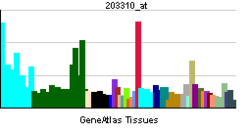Syntaxin binding protein 3
| View/Edit Human | View/Edit Mouse |
Syntaxin-binding protein 3 is a protein that in humans is encoded by the STXBP3 gene.[3][4]
Interactions
Syntaxin binding protein 3 has been shown to interact with STX2[5] and STX4.[5][6]
References
- ↑ "Human PubMed Reference:".
- ↑ "Mouse PubMed Reference:".
- ↑ Reed GL, Houng AK, Fitzgerald ML (May 1999). "Human platelets contain SNARE proteins and a Sec1p homologue that interacts with syntaxin 4 and is phosphorylated after thrombin activation: implications for platelet secretion". Blood. 93 (8): 2617–26. PMID 10194441.
- ↑ "Entrez Gene: STXBP3 syntaxin binding protein 3".
- 1 2 Schraw, Todd D; Lemons Paula P; Dean William L; Whiteheart Sidney W (Aug 2003). "A role for Sec1/Munc18 proteins in platelet exocytosis". Biochem. J. England. 374 (Pt 1): 207–17. doi:10.1042/BJ20030610. ISSN 0264-6021. PMC 1223584
 . PMID 12773094.
. PMID 12773094. - ↑ Widberg, Charlotte H; Bryant Nia J; Girotti Milena; Rea Shane; James David E (Sep 2003). "Tomosyn interacts with the t-SNAREs syntaxin4 and SNAP23 and plays a role in insulin-stimulated GLUT4 translocation". J. Biol. Chem. United States. 278 (37): 35093–101. doi:10.1074/jbc.M304261200. ISSN 0021-9258. PMID 12832401.
Further reading
- Maruyama K, Sugano S (1994). "Oligo-capping: a simple method to replace the cap structure of eukaryotic mRNAs with oligoribonucleotides.". Gene. 138 (1-2): 171–4. doi:10.1016/0378-1119(94)90802-8. PMID 8125298.
- Gengyo-Ando K, Kitayama H, Mukaida M, Ikawa Y (1996). "A murine neural-specific homolog corrects cholinergic defects in Caenorhabditis elegans unc-18 mutants.". J. Neurosci. 16 (21): 6695–702. PMID 8824310.
- Suzuki Y, Yoshitomo-Nakagawa K, Maruyama K, et al. (1997). "Construction and characterization of a full length-enriched and a 5'-end-enriched cDNA library.". Gene. 200 (1-2): 149–56. doi:10.1016/S0378-1119(97)00411-3. PMID 9373149.
- Baccon J, Pellizzoni L, Rappsilber J, et al. (2002). "Identification and characterization of Gemin7, a novel component of the survival of motor neuron complex.". J. Biol. Chem. 277 (35): 31957–62. doi:10.1074/jbc.M203478200. PMID 12065586.
- Strausberg RL, Feingold EA, Grouse LH, et al. (2003). "Generation and initial analysis of more than 15,000 full-length human and mouse cDNA sequences.". Proc. Natl. Acad. Sci. U.S.A. 99 (26): 16899–903. doi:10.1073/pnas.242603899. PMC 139241
 . PMID 12477932.
. PMID 12477932. - Widberg CH, Bryant NJ, Girotti M, et al. (2003). "Tomosyn interacts with the t-SNAREs syntaxin4 and SNAP23 and plays a role in insulin-stimulated GLUT4 translocation.". J. Biol. Chem. 278 (37): 35093–101. doi:10.1074/jbc.M304261200. PMID 12832401.
- Brandenberger R, Wei H, Zhang S, et al. (2005). "Transcriptome characterization elucidates signaling networks that control human ES cell growth and differentiation.". Nat. Biotechnol. 22 (6): 707–16. doi:10.1038/nbt971. PMID 15146197.
- Gerhard DS, Wagner L, Feingold EA, et al. (2004). "The status, quality, and expansion of the NIH full-length cDNA project: the Mammalian Gene Collection (MGC).". Genome Res. 14 (10B): 2121–7. doi:10.1101/gr.2596504. PMC 528928
 . PMID 15489334.
. PMID 15489334. - Fu J, Naren AP, Gao X, et al. (2005). "Protease-activated receptor-1 activation of endothelial cells induces protein kinase Calpha-dependent phosphorylation of syntaxin 4 and Munc18c: role in signaling p-selectin expression.". J. Biol. Chem. 280 (5): 3178–84. doi:10.1074/jbc.M410044200. PMID 15576373.
- Hodgkinson CP, Mander A, Sale GJ (2005). "Identification of 80K-H as a protein involved in GLUT4 vesicle trafficking.". Biochem. J. 388 (Pt 3): 785–93. doi:10.1042/BJ20041845. PMC 1183457
 . PMID 15707389.
. PMID 15707389.
This article is issued from Wikipedia - version of the 6/6/2016. The text is available under the Creative Commons Attribution/Share Alike but additional terms may apply for the media files.


